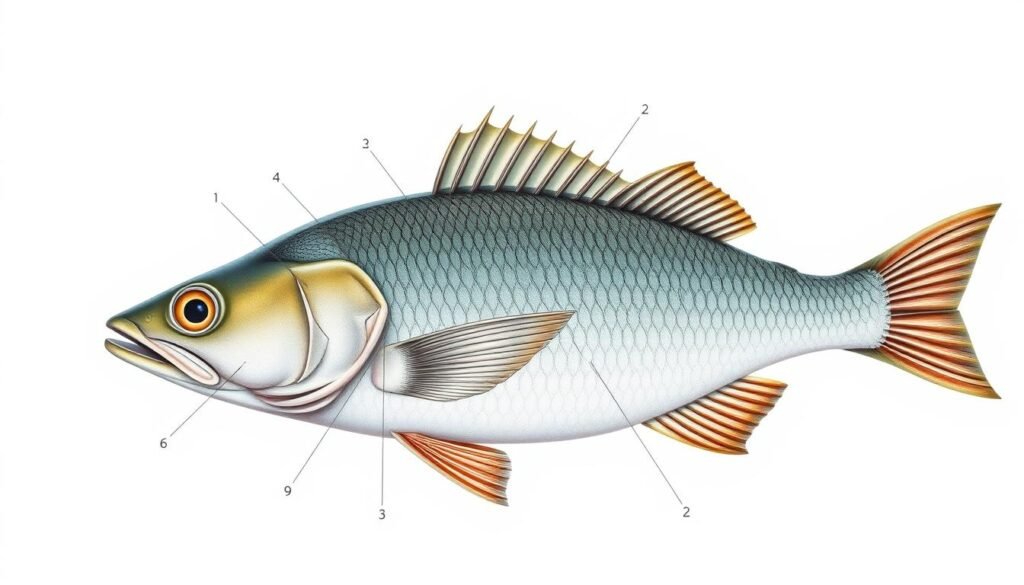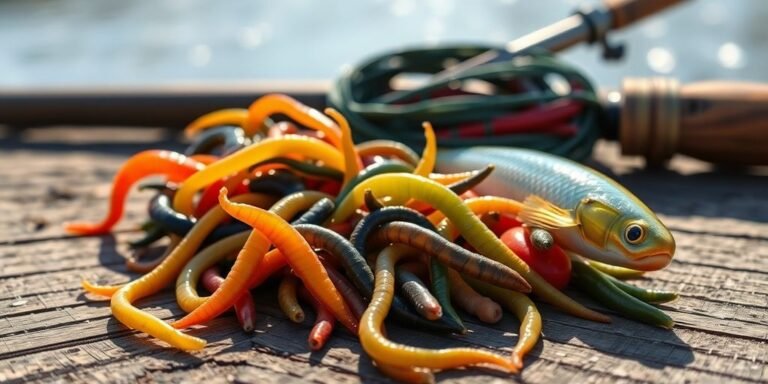Being able to recognize common fish species is crucial for any angler. Not only does it enhance your fishing experience, but it also helps in conservation efforts. Understanding the basics of fish anatomy and using simple mnemonics like BAMFAD can make a significant difference.
The BAMFAD mnemonic is a useful tool that provides a systematic approach to fish identification. By breaking down the characteristics of the fish into manageable parts, anglers can more accurately determine the species they catch.
Key Takeaways
- Understanding fish anatomy is crucial for identification.
- Using mnemonics like BAMFAD can simplify the identification process.
- Recognizing common species enhances the fishing experience.
- Accurate identification aids in conservation efforts.
- A systematic approach to fish identification is beneficial.
The Importance of Proper Fish Identification
Understanding the importance of correct fish identification is essential for Australian anglers, as it impacts both conservation efforts and legal compliance. Accurate identification ensures that anglers can distinguish between protected and permissible species, thereby supporting sustainable fishing practices.
Legal Requirements for Anglers in Australia
In Australia, anglers are required by law to identify their catch correctly to comply with local fishing regulations. This includes understanding size limits, bag limits, and species-specific restrictions. For instance, some species may be protected or have specific catch limits to prevent overfishing.
| Species | Size Limit | Bag Limit |
|---|---|---|
| Murray Cod | 55 cm | 1 |
| Australian Bass | 30 cm | 4 |
Conservation and Sustainable Fishing Practices
Proper fish identification aids in conservation by ensuring that anglers can identify and release undersized or protected species unharmed. This practice helps maintain fish populations and supports ecological balance. Using visual fish ID techniques and consulting a fish species guide can significantly enhance an angler’s ability to identify species correctly.
By combining legal compliance with conservation practices, anglers can contribute to the long-term sustainability of Australia’s fish populations. This not only benefits the environment but also ensures the future of recreational fishing in the country.
Understanding Basic Fish Anatomy
Understanding the fundamental structure of fish is essential for accurate identification. Fish anatomy provides crucial clues for recognizing different species, and mastering this knowledge is vital for both novice and experienced anglers.
Read Also: Different Barramundi Species: A Complete Species Overview
Key Body Parts Used in Identification
To identify fish effectively, it’s necessary to understand the key body parts that are commonly used in the identification process. The BAMFAD mnemonic is a helpful tool that reminds us to observe the following features:
- Body shape: The overall shape and proportions of the fish.
- Appearance: Color, patterns, and any distinctive markings.
- Mouth: The size, shape, and orientation of the mouth.
- Fins: The number, type, and configuration of fins.
- Area: The habitat or region where the fish is found.
- Demeanor: The behavior and movement patterns of the fish.
Common Terminology for Fish Description
Familiarity with common terminology is crucial for describing and identifying fish. Terms such as “dorsal fin,” “lateral line,” and “caudal peduncle” are frequently used to describe specific anatomical features. Understanding these terms helps in using field guides and other identification resources effectively.
| Term | Description |
|---|---|
| Dorsal Fin | The fin located on the back of the fish. |
| Lateral Line | A sensory organ that runs along the sides of the fish, detecting vibrations. |
| Caudal Peduncle | The narrow part of the fish’s body where the tail fin is attached. |
Measuring Fish Correctly
Measuring fish accurately is a critical aspect of identification. The standard length is typically measured from the tip of the snout to the end of the caudal fin. It’s essential to follow consistent measurement techniques to ensure reliable data.

By understanding and applying the basics of fish anatomy, anglers can significantly improve their ability to identify fish species accurately. This knowledge not only enhances the fishing experience but also contributes to conservation and sustainable fishing practices.
How to Identify Fish: Essential Methods and Tools
To accurately identify fish species, anglers and researchers rely on a combination of traditional field guides and modern technology. This blend of old and new methods provides a comprehensive approach to understanding the diverse range of fish species.
Australian Field Guides and Mobile Apps
Australian field guides are invaluable resources for identifying fish. They provide detailed descriptions and images of various species. Mobile apps like iNaturalist and FishBase have also become essential tools, offering accessible and up-to-date information on fish species. These apps often include features such as image recognition and community sharing, enhancing the identification process.
Some popular field guides for Australian fish include the “Field Guide to Freshwater Fishes of Australia” and “Australian Fish: A Guide to Identification.” These guides cover a wide range of species, providing information on habitat, behavior, and distinctive characteristics.
Photography Techniques for Identification
Photography plays a crucial role in fish identification. High-quality images can help capture key features such as coloration, fin shape, and scale patterns. When photographing fish, it’s essential to get clear shots of the fish from multiple angles, including the side, front, and dorsal views.
Measurement and Documentation Tools
Accurate measurement and documentation are vital for precise fish identification. Tools such as measuring tapes, scales, and data sheets help record essential information like length, weight, and distinguishing features. Digital tools and apps can also be used to log data and compare it with existing records.
| Tool | Purpose | Benefits |
|---|---|---|
| Field Guides | Identify fish species | Detailed descriptions and images |
| Mobile Apps | Access species information | Image recognition, community sharing |
| Photography | Capture fish features | Clear images from multiple angles |
| Measuring Tools | Record fish measurements | Accurate length and weight data |
Primary Visual Identification Features
To identify fish effectively, one must consider various visual cues that distinguish one species from another. Visual identification is a crucial skill for anglers, marine biologists, and conservationists. It involves observing several key characteristics that are unique to each fish species.
Body Shape and Size
The body shape and size of a fish are among the first features observed during identification. Different species exhibit a wide range of body shapes, from the elongated bodies of eels to the flat bodies of flounders. For instance, the Murray Cod, a native Australian species, has a distinctive elongated body shape that can grow up to 1.8 meters in length.
Fin Configuration and Placement
The configuration and placement of fins are critical for identifying fish. Fins come in different shapes and sizes, and their placement on the body can vary significantly between species. For example, the dorsal fin of a shark is quite different from that of a salmon. Understanding these differences is key to accurate identification.
| Species | Dorsal Fin Shape | Placement |
|---|---|---|
| Shark | Triangular | Back |
| Salmon | Convex | Back, closer to tail |
Coloration and Markings
Coloration and markings are among the most distinctive features of fish. Different species display a wide array of colors and patterns, from the vibrant stripes of the Thunnus thynnus (Bluefin Tuna) to the mottled camouflage of the Flathead. These visual cues can be crucial for identification, especially in environments with diverse species.
“The color patterns on a fish can be as unique as fingerprints, providing a reliable means of identification.” – Marine Biologist
Mouth and Head Structure
The structure of a fish’s mouth and head can provide significant clues about its identity. For example, the size and shape of the mouth can indicate the fish’s feeding habits. According to a study on fish identification techniques, understanding the morphology of a fish’s head and mouth is crucial for accurate.
By focusing on these primary visual identification features, individuals can improve their ability to identify fish species accurately. Whether for conservation, fishing, or simply out of curiosity, developing this skill enhances one’s appreciation and understanding of the diverse world of fish.
Common Australian Freshwater Fish Species
Understanding the common freshwater fish species in Australia is essential for anglers and conservationists alike. Australia’s diverse freshwater ecosystems support a wide range of fish, from native species that have evolved over millions of years to introduced species that have been brought in for sport or accidentally released.
Native Species: Murray Cod, Australian Bass, and Yellowbelly
Some of the most iconic native freshwater fish in Australia include the Murray Cod, Australian Bass, and Yellowbelly. The Murray Cod is Australia’s largest freshwater fish, capable of growing up to 1.8 meters in length and weighing over 100 kilograms. It has a mottled green and brown coloration, helping it blend into the murky waters it inhabits.
The Australian Bass is another significant native species, primarily found in coastal rivers and streams. It is known for its strong fighting ability when hooked, making it a popular target for sport fishermen. The Yellowbelly, also known as the Golden Perch, is recognized by its golden color and is widespread across the Murray-Darling Basin.
Smaller Natives: Gudgeons, Galaxias, and Rainbowfish
Australia is also home to numerous smaller native freshwater fish species, such as Gudgeons, Galaxias, and Rainbowfish. Gudgeons are small, typically bottom-dwelling fish that are often found in schools. Galaxias are another small native fish, known for their slender bodies and ability to inhabit a variety of freshwater habitats.
Rainbowfish, with their vibrant colors, add beauty to the freshwater environments. They are generally found in schools and are known for their peaceful nature.
Introduced Species: Carp, Redfin, and Trout
Australia’s freshwater ecosystems have also been impacted by the introduction of non-native fish species. Carp, for example, are highly invasive and have caused significant environmental damage. They are easily identified by their robust body and barbels around the mouth.
Redfin, another introduced species, is known for its aggressive behavior and can outcompete native species for resources. Trout, including both Brown Trout and Rainbow Trout, have been introduced for recreational fishing and are found in cooler waters, particularly in the southeastern regions.
Understanding these common Australian freshwater fish species is crucial for effective conservation and management of freshwater ecosystems. By being able to identify these species, anglers and conservationists can contribute to the preservation of Australia’s rich freshwater biodiversity.
Identifying Popular Australian Saltwater Species
Saltwater fishing in Australia involves recognizing a multitude of species, each with unique characteristics. The country’s diverse marine environments, from inshore waters to offshore reefs, are home to a wide variety of fish. Understanding how to identify these species is crucial for both recreational and commercial anglers.
Inshore Species: Bream, Flathead and Whiting
Inshore species are commonly found in estuaries, bays, and coastal waters. Bream, Flathead, and Whiting are popular inshore species in Australia. Bream are typically found in estuaries and are recognized by their deep bodies and yellow fins. Flathead have a distinctive flat head and are often found in sandy or muddy bottoms. Whiting, on the other hand, are smaller and have a more elongated body.

Offshore Species: Snapper, Mackerel and Tuna
Offshore species inhabit the deeper waters beyond the coastal zone. Snapper, Mackerel, and Tuna are highly prized by anglers. Snapper are known for their pink or red color and are often caught near reefs. Mackerel are recognized by their striped bodies and are a fast-swimming species. Tuna, with their metallic blue bodies, are highly sought after for their strength and speed.
| Species | Common Habitat | Distinguishing Features |
|---|---|---|
| Bream | Estuaries, bays | Deep body, yellow fins |
| Flathead | Sandy or muddy bottoms | Flat head, camouflaged body |
| Snapper | Reefs, offshore waters | Pink or red color |
Reef Fish Identification Techniques
Reef fish identification requires a good understanding of the various species that inhabit coral reefs. Techniques include observing the fish’s color, shape, and behavior. Many reef fish have bright colors and distinctive patterns, making them easier to identify. Using field guides or mobile apps can also aid in the identification process.
Estuarine Species Recognition
Estuaries are complex ecosystems that support a wide range of fish species. Recognizing estuarine species involves understanding their adaptations to brackish water environments. Common estuarine species include Mulloway and Yellowfin Bream. These species often have unique physiological adaptations that allow them to thrive in varying salinity levels.
By mastering the techniques for identifying these popular Australian saltwater species, anglers can enhance their fishing experience and contribute to sustainable fishing practices. Whether you’re targeting inshore species or venturing offshore, accurate identification is key to enjoying Australia’s rich marine biodiversity.
Recognising Protected and Dangerous Species
The ability to identify protected and dangerous fish species is essential for sustainable fishing practices and marine conservation. Australian waters are home to a diverse range of fish, including species that are protected by law and others that can pose a threat to human safety.
Protected Species in Australian Waters
Australia is committed to conserving its unique marine biodiversity. Certain fish species are protected to ensure the sustainability of marine ecosystems. For instance, the grey nurse shark and white shark are protected under Australian law. Recognising these species is crucial for anglers and divers to avoid unintentionally harming them.
| Protected Species | Identifying Features | Habitat |
|---|---|---|
| Grey Nurse Shark | Robust body, grey-brown color | Coastal waters, rocky reefs |
| White Shark | Large size, white underbelly | Coastal and offshore waters |
Identifying Venomous and Dangerous Fish
Some fish in Australian waters can be venomous or dangerous. The stonefish, for example, is one of the most venomous fish in the world. It is camouflaged and can be difficult to spot. Understanding the habitats and characteristics of such fish is vital for safety.
Look-alike Species and Common Misidentifications
Many fish species can be easily confused with one another. For example, the blue swimmer crab is often misidentified with other crab species. Being able to distinguish between look-alike species is important for both conservation and safety. Using a fish species guide can help in accurate identification.
By learning to identify protected and dangerous fish species, anglers and marine enthusiasts can contribute to conservation efforts and ensure a safer experience in Australian waters.
Seasonal and Regional Identification Challenges
Australian fish species exhibit significant variations due to seasonal and regional factors, complicating identification. Understanding these challenges is crucial for accurate visual fish ID.
Seasonal Variations in Fish Appearance
Fish can change appearance significantly with the seasons. For instance, some species may develop brighter colors during mating seasons, while others may change their feeding habits, affecting their size and shape. A study on the seasonal succession of larval fish communities highlights the importance of considering these variations in fish identification.
Northern vs Southern Australian Species
The diverse marine life in northern and southern Australia presents different identification challenges. Tropical species in the north, such as certain types of damselfish, differ significantly from temperate species found in the south, like the Maugean skate. Using a comprehensive fish species guide is essential for distinguishing between these regional variations.
East Coast vs West Coast Fish Variations
Australia’s east and west coasts host different fish populations due to varying marine environments. For example, the east coast is known for its coral reefs, home to a diverse array of species like parrotfish and butterflyfish, whereas the west coast features a mix of temperate and tropical species. Understanding these regional differences is key to successful fish identification.
Juvenile vs Adult Identification Differences
Juvenile fish often look very different from their adult counterparts, making identification challenging. For instance, juvenile trevallies may have different color patterns and fin shapes compared to adults. Recognizing these differences is crucial for accurate identification.
| Region | Common Species | Seasonal Variation |
|---|---|---|
| Northern Australia | Tropical species like damselfish | Bright colors during mating season |
| Southern Australia | Temperate species like Maugean skate | Changes in feeding habits |
| East Coast | Coral reef species like parrotfish | Variations in color and pattern |
Conclusion
Accurately identifying fish is a crucial skill for anglers, conservationists, and anyone who appreciates Australia’s diverse aquatic life. By understanding how to identify fish using visual characteristics and field guides, you can enhance your fishing experience and contribute to sustainable fishing practices.
Throughout this article, we’ve explored the essential methods and tools for visual fish ID, from understanding basic fish anatomy to recognizing common Australian freshwater and saltwater species. We’ve also discussed the importance of proper fish identification for conservation and legal compliance.
By applying the tips and techniques outlined in this fish species guide, you’ll be better equipped to identify the fish you encounter, whether you’re fishing in the Murray River or exploring the Great Barrier Reef. Remember to stay up-to-date with local regulations and continue learning about the diverse fish species found in Australian waters.
With practice and patience, you’ll become proficient in identifying fish and develop a deeper appreciation for Australia’s rich aquatic biodiversity.





